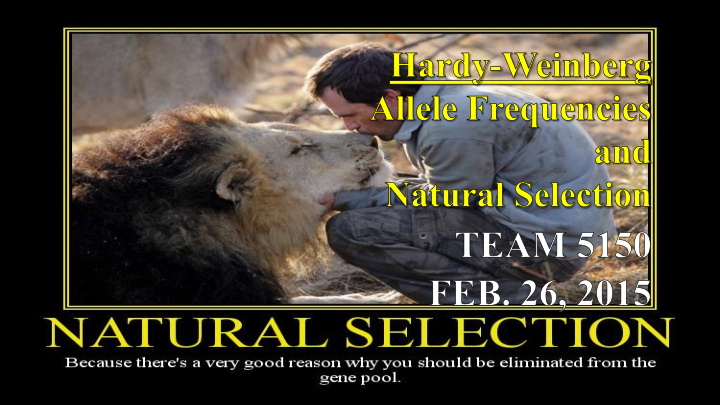



What is Natural What is Gene Selection? Frequency? The process by which forms of life Gene frequency is the frequency having traits that better enable of occurrence or proportions of them to adapt to specific different alleles of a particular environmental pressures, as gene in a given population. It is predators, changes in climate, or usually expressed as a proportion competition for food or mates, will or a percentage, and describes tend to survive and reproduce in the amount of genetic diversity greater numbers than others of at the individual, population, or their kind, thus ensuring the species level. (1) perpetuation of those favorable traits in succeeding generations.(1)
How can Natural Selection and Allele Frequencies effect one another? Natural Selection can increase or decrease an alleles frequency. If the allele produces a phenotype which is advantages then their frequency will increase, however if it is not advantageous, the frequency will decrease. They both work together to accelerate evolution or against each other to slow evolution.
Gene Frequency Methods Add all the beads in one cup and mixed • Randomly pick two bead pairs to determine the phenotype and genotype and record the data • Case1: 50 red beads, 50 white beads to create RR homozygous dominant, Rw heterozygous, ww homozygous recessive 33% deduction of ww homozygous recessive per generation for 6 generations Case 2: 50 red beads, 50 white beads to create RR homozygous dominant, Rw heterozygous, ww homozygous recessive 100% deduction of ww homozygous recessive per generation for 6 generation Case 3: 40 red, 40 white, 20 black beads to create RR homozygous dominant, Rw heterozygous, ww homozygous recessive, RB heterozygous mutation, Bw heterozygous mutation and BB homozygous mutation. 100% deduction of ww, 150% survival of RB, and 200% survival of BB homozygous for each generation for 6 generations Case 4: 40 red, 40 white, 20 black beads to create RR homozygous dominant, Rw heterozygous, ww homozygous recessive, RB heterozygous mutation, Bw heterozygous mutation and BB homozygous mutation. 100% deduction for ww, 100% deduction of BB, and 50% deduction of RB
Natural Selection Methods 1) Choose 40 same colored dots 2) 20 of those dots will go onto a colored cloth mat symbolizing an environment and the dots will symbolize species. 3) Predators: (only get 1 minute) Generation #1- one person, one hand Generation #2- one person, two hands Generation #3- two people, one hand Generation #4- two people, two hands * Environment is changed (new colored place mat) Generation #5- two people, two hand (lights going on and off) Generation #6- Natural Disaster(playing card) 4) Take count of dead for each generation and record data * If any colors/generation die out then a new color/generation will be added. 5) Each time we enter our results for each generation, we would add back the offspring for each back into the environment.
Gene Frequency Results Case� 1:� -33%� ww� Case� 2:� -100%� ww� 80.0%� 100.0%� 70.0%� 80.0%� 60.0%� 60.0%� Popula on� 50.0%� Popula on� RR-33%ww� RR-100%� ww� 40.0%� of� 40.0%� of� Percent� Percent� Rw-33%� ww� Rw-� 100%� ww� ww-33%� ww� ww-100%� ww� 30.0%� 20.0%� 20.0%� 0.0%� 10.0%� Gen� 1� Gen� 2� Gen� 3� Gen� 4� Gen� 5� Gen� 6� Gen� 7� Gen� 8� Gen� 9� Gen� 10� Gen� 11� Gen� 12� 0.0%� -20.0%� Gen� 1� Gen� 2� Gen� 3� Gen� 4� Gen� 5� Gen� 6� Gen� 7� Gen� 8� Gen� 9� Gen� 10� Gen� 11� Gen� 12� Genera on� Genera on� � Figure1 Case#1 and Case#2 decrease in Rw and ww due to Figure 2 the negative selection of the ww genotype.
Gene Frequency Results Case� 3:� Posi ve� Muta on� Case� 4:� Nega ve� Muta on� 80%� 80%� 70%� 60%� 60%� 40%� 50%� Popula on� RR� Pos tve� Muta on� RR� Nega ve� Muta on� Popula on� 40%� Rw� Posi ve� Muta on� Rw� Nega ve� Muta on� 20%� ww� Pos ve� Muta on� ww� Nega ve� Muta on� 30%� of� of� Percent� RB� Posi ve� Muta on� RB� Negai ve� Muta on� Percent� 0%� wB� Posi ve� Muta on� wB� Negai ve� Muta on� 20%� Gen� 1� Gen� 2� Gen� 3� Gen� 4� Gen� 5� Gen� 6� Gen� 7� Gen� 8� Gen� 9� Gen� 10� Gen� 11� Gen� 12� BB� Posi ve� Muta on� BB� Nega� Muta on� 10%� -20%� 0%� Gen� 1� Gen� 2� Gen� 3� Gen� 4� Gen� 5� Gen� 6� Gen� 7� Gen� 8� Gen� 9� Gen� 10� Gen� 11� Gen� 12� -40%� -10%� -20%� Genera on� -60%� Genera on� Figure 3 Figure 4 Case #3: Increase in both Homozygous Case #4: RR, Rw, wB show little to no growth due Dominant BB (200% survival) and Heterozygous to neutral survival. RB increased slightly due to dominant RB (150% survival) due to the positive 50% survival. BB and ww declined due to 0% mutation . Decrease in RR, Rw, ww, and wB due survival. to neutral/negative survival.
Natural Selection Results Figure 5 Figure 6 Through generations 1-5 we were able to see natural selection at work as the phenotypes were • not well suited for the environment and were consistently killed off. Generation 6 we witnessed the bottle neck effect with the natural disaster.
Natural Selection vs Allele Frequency Figure 8 Figure 7 As long as the Phenotype is beneficial then the species will have a will have a positive compound annual growth rate %.
Conclusion Natural selection acts more on the phenotype than on the genotype.(2) Natural selection acts indirectly via how the genotype affects the phenotype. (2) Allele frequency can be changed by Natural Selection, gene flow, and genetic drift, yet only Natural selection consistently improves the match between organisms and their environment. (2) Evolution is therefore achieved because of Natural Selection.
Citations 1)http://dictionary.reference.com/b rowse/gene+frequency 2)Reece, Jane B. "22 Descent with Modification: A Darwinian View of Life." Campbell Biology . 9.th ed. San Francisco: Pearson Benjamin Cummings, 2011. 460. Print. 3)https://solano.instructure.com/co urses “Hardy - Weinberg Law” lab instructions
Recommend
More recommend